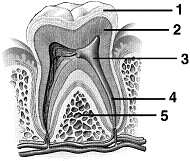Which molecule catalyzes covalent bond formation between fragments of DNA?
A. nuclease
B. helicase
C. primase
D. ligase
E. polymerase
Answer: D
You might also like to view...
Motor proteins require energy in the form of ATP. ATP hydrolysis results in a conformational change that allows the protein to move along microtubular tracks (pathways). What structural component of the motor protein contains the ATP binding site
and, therefore, changes shape to enable movement? A) the portion of the molecule that binds to the vesicle being transported B) the stalk C) the portion of the molecule that binds to the microtubular track along which the vesicle is being transported D) a location midway between the vesicle binding site and the portion of the molecule that binds to microtubular tracks
The abiotic factor that has had the greatest evolutionary effects on deep-sea animals is:
a. low temperatures. b. high pressure. c. low nutrients. d. lack of light. e. varying salinity.
Four of the five answers listed below are related by a common theme. Select the exception
a. alcohol b. thalidomide c. German measles d. vitamins e. antibiotics
Refer to Figure 47-1. The root of the tooth is made up of the parts labeled:

a. 4 and 5 only
b. 3, 4, and 5 only
c. 1, 2, and 3 only
d. 1, 2, 3, and 4 only
e. 1, 2, 3, 4, 5